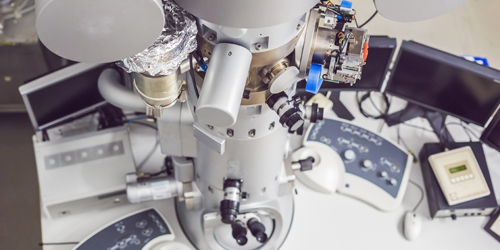Narrower-Energy Electron Pulses without Electron Loss
Conceived a century ago, electron microscopes are today standard fare in experimental research laboratories. By imaging a material with electrons, scientists can resolve details 1000 times smaller than is possible with light. These devices can also employ pulsed electron beams to probe transient phenomena, such as the behavior of quasiparticles that a material hosts. Now Michael Yannai of Technion–Israel Institute of Technology and his colleagues demonstrate a way to improve that capability by reducing the energy spread of the electrons in a pulsed imaging beam [1]. Their method leaves the brightness of the beam unchanged, which is important for ultrafast imaging, as the ultrashort pulses used in this method necessarily comprise small numbers of electrons. “Our technique opens the path to many potential time- and energy-resolved explorations that are currently impossible,” says Ido Kaminer, who headed the team behind the research.
Electron energy spread is one of the key factors limiting an electron microscope’s resolution. The smaller this spread—the closer the beam is to being monochromatic—the better the resolution. The conventional method for reducing energy spread is to filter out electrons with energies outside of the desired range. But that process significantly reduces the electron flux, another factor that can limit a microscope’s performance.
In the lossless monochromator demonstrated by Yannai and his colleagues, none of the electrons are filtered out of the beam, meaning its initial flux is maintained. Instead, the team adjusts the energy of the electrons outside of the desired energy range using terahertz electric fields. They do this by varying the electric fields temporally and spatially so that more energetic electrons are decelerated by the field, while less energetic ones are accelerated.
–Katherine Wright
Katherine Wright is the Deputy Editor of Physics Magazine.
References
- M. Yannai et al., “Lossless monochromator in an ultrafast electron microscope using near-field THz radiation,” Phys. Rev. Lett. 131, 145002 (2023).




